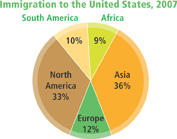Bar and Circle Graphs
Sometimes you can draw different graphs to represent the same data, depending on the information you want to share. A bar graph is useful for comparing amounts; a circle graph is useful for comparing percents.
Example
Display the 2007 data on immigration to the United States in a bar graph and a circle graph.
To make a circle graph, first find the percent of the data in each category. Then express each percent as a decimal and multiply by
Draw a circle and use a protractor to draw each central angle.
| Place of Origin | Immigrants (1000's) |
|---|---|
| Africa | 89.2 |
| Asia | 359.4 |
| Europe | 120.8 |
| North America | 331.7 |
| South America | 102.6 |
SOURCE: Department of Homeland Security
To make a bar graph, place the categories along the bottom axis. Decide on a scale for the side axis. An appropriate scale would be 0–300, marked in intervals of 50. For each data item, draw a bar whose height is equal to the data value.
Exercises
Display the data from each table in a bar graph and a circle graph.
-
NASA Space Shuttle Expenses, 2000 Operation Millions of Dollars Orbiter, integration 698.8 Propulsion 1,053.1 Mission, launch operations 738.8 Flight operations 244.6 Ground operations 510.3 SOURCE: U.S. National Aeronautics and Space Administration
-
Cable TV Revenue, 2006 Millions of Dollars Airtime 4,566 Basic service 42,918 Pay-per-view, premium services 13,322 Installation 729 Other 27,188 SOURCE: U.S. Census Bureau
Table of Contents
- 5-1 Polynomial Functions
- 5-2 Polynomials, Linear Factors, and Zeros
- 5-3 Solving Polynomial Equations
- 5-4 Dividing Polynomials
- 5-5 Theorems About Roots of Polynomial Equations
- 5-6 The Fundamental Theorem of Algebra
- 5-7 The Binomial Theorem
- 5-8 Polynomial Models in the Real World
- 5-9 Transforming Polynomial Functions






